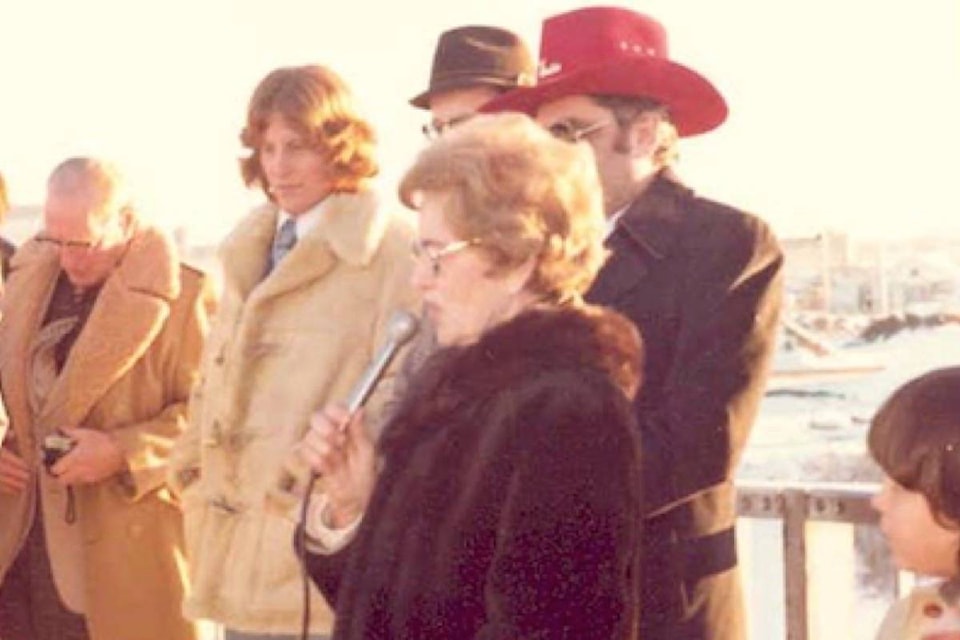The main roadway going north and south on the west side of the city is Taylor Drive, and it crosses the river on Taylor Bridge.
Both the bridge and the thoroughfare are named in honour of one of the most active and dynamic people in the history of our community – Ethel Taylor.
Ethel Watson Taylor was born in 1908 in Gwelo, Rhodesia, in what is now Zimbabwe. In 1913, little Ethel had been struck with a severe case of malaria. Consequently, the family moved back to Fort Macleod, where her grandfather had established a ranch in 1891.
Ethel’s mother died when Ethel was still quite young, and her father was largely absent afterwards. While relatives helped to raise the family, Ethel often found herself acting as a parent to her young siblings.
In 1928, Ethel married a school teacher, Hugh Taylor, and they lived at Blackie. In 1940, they moved up to Red Deer to a new home on Waskasoo Crescent.
Although she described herself as quite shy at the time, Ethel soon became incredibly active in the community. She became a founding member of the Red Deer branch of the Alberta Women’s Institute.
She became a leader for Canadian Girls’ In Training and became active with the local Home and School Association. She helped to found the Quota Club, Red Deer Local Council of Women and the Red Deer Allied Arts Council.
She became active with the Alberta Drama League. She helped to organize numerous plays, concerts and art exhibitions in the community.
Other community groups with which Taylor became very active were the Red Deer Hospital Auxiliary, the Alberta Council on Aging, the Red Deer Kindergarten Society, the Red Deer Film Society and the Red Deer Craft Centre.
She became a very active member of the CCF/NDP, running twice provincially and twice federally. In 1961, Taylor became the first woman to be elected to Red Deer city council.
One cause to which Taylor was particularly dedicated was the library. She pushed hard for the construction of the Red Deer Centennial Library in 1966 and 1967, despite some significant resistance to the project in the community because of the cost.
Over the years, Taylor became even more active with a number of civic boards and organizations. She helped to found the Social Welfare Committee, the Social Planning Council, the Family Service Bureau and the Red Deer and District Social Services Board.
She became a member of the Twilight Homes Foundation, the parks board, the recreation board, the Red Deer Exhibition Board, the Red Deer Health Unit, the Red Deer and District Archives Committee, the G.H. Dawe Community Centre Management Board, the Golden Circle and the Gaetz Lakes Sanctuary Committee.
In short, there were very few civic or community groups with which Taylor was not involved. Her energy and dynamism were astonishing.
Very often, not only was she elected as chair or president of the local organization, but she then became a representative or member with the related provincial and national associations.
In 1977, Taylor was named Red Deer’s citizen of the year. A former member of the University of Alberta senate, she was awarded an honorary doctorate by the U of A in 1982.
In 1979, when a third bridge was built across the Red Deer River, it and the connecting roadway were named in her honour.
In 1991, when the arterial road was built south along the old CPR right-of-way, it became part of Taylor Drive, thereby making it the major transportation route on the west side of the city.
In 1988, due to failing health, Taylor moved to Calgary to be closer to her family. She passed away there on May 24, 1989.
She was survived by her three children, Laughlin, Ron and Mary Kay, seven grandchildren and two great-grandchildren.
Red Deer historian Michael Dawe’s column appears Wednesdays.
